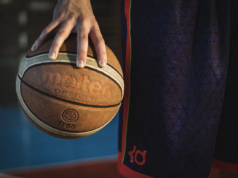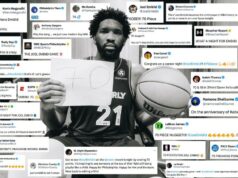Trey Gilder, we hardly knew ye.
Last week it was reported the San Antonio Spurs had brought Gilder in for a workout, which led most to deduce he’d be joining the team for their 2010-11 training camp.
Not so much.
In what is at the very least coincidental and in the very likely correlation, the Spurs and Bobby Simmons are now in the courting phase.
Popovich and the Spurs have made no secret of their less-than-certain status behind Richard Jefferson at the small forward position. They’ve made no claims that they in fact know exactly how they plan to address the need and complete their roster’s puzzle.
They’re keeping an open mind and given the dearth of free-agent options, they’re probably open to suggestion.
So it should come as no surprise what was believed to be a week ago, isn’t the reality of today. Simmons simply wasn’t on their radar, or at least wasn’t believed to be attainable.
He is now.
Simmons didn’t seek out the Spurs the way Keith Bogans did a year ago. He made the rounds and was actually working out for the Mavs about the same time Gilder was working out for the Spurs. But like so many things in life it doesn’t matter how you get there, only that you do.
Simmons is “there,” with the Spurs, so what now?
One of the D-League’s first significant success stories, the NBA’s 2004-05 Most Improved Player and eventual $46.4 million-dollar-man, Simmons comes with plenty of question marks.
As Mark Deeks of ShamSports puts it:
Simmons’s career transition from “can do anything except shoot” to “can do nothing but shoot” is complete.
While simplistic and a bit tongue-in-cheek, the best humor’s usually weighted in truth.
Deeks (Sham) isn’t all that off-base.
Simmons has always had an ideal build for a small forward. He’s over 6-7 in shoes, he’s got a 7-foot wingspan, he’s by no means frail … he’s nothing if not a quality piece of clay.
After being traded twice, waived and being drafted by the Mobile Revelers two years after entering the league, Simmons molded himself into a quality midrange player. Free-throw line extended and off the elbows, chances are you’d see a quality shot and not too many turnovers, either.
 While the shooting is still likely there and the ability to take care of the ball likely remains, that “can do anything except shoot” seems a distant memory. Between surgeries, age and the affect playing on bad teams has on one’s fundamentals, edge and focus, one has to wonder just how effective a player he still is.
While the shooting is still likely there and the ability to take care of the ball likely remains, that “can do anything except shoot” seems a distant memory. Between surgeries, age and the affect playing on bad teams has on one’s fundamentals, edge and focus, one has to wonder just how effective a player he still is.
Offensively, at this point, he could actually do quite well playing off a trio like the Big 3. He’s not a player that’s looking to create on his own, get to the free-throw line or make plays for others, he’s a finisher — so long as it’s not at or above the rim. Give him a skip-pass, hit him in transition, find him on a kickout for a midrange jumper, off a rotating defense or just an in-rhythm 3, Simmons is a capable player — it’s not out of the realm he could actually look a better fit offensively than Jefferson at times. It’s simply skill-set.
Prior to this past year, Simmons averaged 47.5% from the 3-point line’s left corner on 137 attempts. He also managed to shoot 44.6% from the right corner during the 2008-09 season, which could bode well for him and the Spurs. It’s no secret the small forward sees plenty of opportunities from the corners — the spacing is partially dependent upon those opportunities and it’s one of the reasons Jefferson’s abandoning of the 3-point line during last year’s playoffs really compromised the Spurs half-court offense; closer in proximity, easier to defend.
Defensively, Simmons and Jefferson are of a similar mold at this stage. At his best, Simmons is more adept at disrupting passing lanes and moving his feet than Jefferson, but he’s in no way leaps and bounds a better defender. They’re both physically strong and capable against players of similar stature but their effectiveness tends to depend upon the opposition, not necessarily the other way around.
Seeing as last year can’t be used as any true barometer or gauge by which to judge the player Simmons has become, not when he was viewed as nothing more than an expiring contract and apart from their current youth movement, one can only look to the most recent play in order to get the best read possible.
In the last two seasons prior to last year (2007-08, 2008-09) Simmons has averaged:
- Games: 70.5
- Minutes: 23.05
- Points: 7.7
- FG%: 43.5
- 3P%: 39.9
- PER: 11.15
Somewhat amazingly, Simmons has only surpassed what’s deemed to be the average player’s PER mark, 15, in one season (2004-05).
The Spurs can’t solely depend on Manu Ginobili and George Hill to provide all of their postseason 3-point shooting and given their other potential options are a rookie (Jame Anderson) and two veterans making the jump from overseas (Gary Neal and Kirk Penney), it couldn’t hurt to have another option at their disposal.
However, Popovich is impressed with Simmons albeit it is just the beginning of training camp.
“Bobby has been impressive because he came without a guarantee,” Popovich said. “He wanted to show that he’s better than what the conventional wisdom is out there.”
The risk is minimal, the reward isn’t all that high. But if the best of what’s left of Simmons comes to fruition, he’d be a nice addition.
Just not the final piece to the puzzle.





